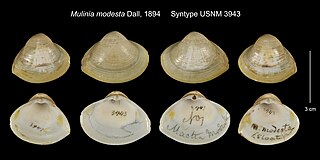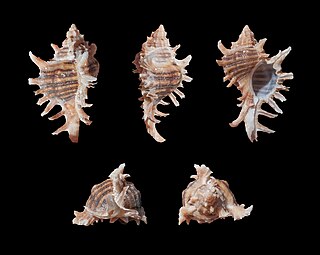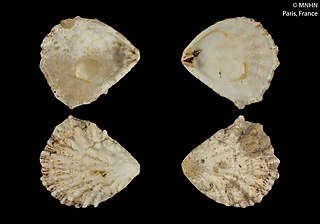
Lima is a genus of file shells or file clams, marine bivalve molluscs in the family Limidae, the file shells, within the subclass Pteriomorphia.

Perna perna, the brown mussel, is an economically important mussel, a bivalve mollusc belonging to the family Mytilidae. It is harvested as a food source but is also known to harbor toxins and cause damage to marine structures. It is native to the waters of Africa, Europe, and South America and was introduced in the waters of North America.

Mulinia modesta is a species of clam belonging to the family Mactridae.

Chicoreus brevifrons, common name the West Indian murex, is a species of predatory sea snail, a marine gastropod mollusk in the family Muricidae, the murex snails.

Stramonita haemastoma, common name the red-mouthed rock shell or the Florida dog winkle, is a species of predatory sea snail, a marine gastropod mollusc in the family Muricidae, the rock snails.

Pyrgocythara plicosa, common name the plicate mangelia, is a species of sea snail, a marine gastropod mollusk in the family Mangeliidae.

Tellinella listeri, the speckled tellin, is a bivalve mollusc in the family Tellinidae, the tellins.

Tucetona pectinata, or the comb bittersweet, is a species of bivalve mollusc in the family Glycymerididae.

Lima lima, or the spiny fileclam, is a species of bivalve mollusc in the family Limidae.

Plicatula gibbosa, commonly known as the Atlantic kitten's paw, is a species of bivalve mollusc in the family Plicatulidae.

Polymesoda floridana, also known as the maritime marsh clam, is a species of bivalve mollusc in the family Cyrenidae.

Astarte elliptica, or the "elliptical astarte", is a species of bivalve mollusc in the family Astartidae. It can be found along the Atlantic coast of North America, ranging from Greenland to Massachusetts.

Lucina amiantus, or the decorated lucine, is a species of bivalve mollusc in the family Lucinidae.
Pleurolucina leucocyma, or the saw-toothed pen shell, is a species of bivalve mollusc in the subfamily Lucininae of the family Lucinidae.

Periglypta is a genus of bivalves in the subfamily Venerinae of the family Veneridae.

Lamelliconcha circinata, common name the "purple venus clam", is a species of bivalve mollusc in the family Veneridae, the venus clams. This species can be found around the coasts of the islands in the West Indies.
Pitarenus cordatus, or the cordate venus clam, is a species of bivalve mollusc in the family Veneridae. It can be found throughout the Gulf of Mexico and the Florida Keys.

Hysteroconcha dione or the elegant Venus clam, formerly known as Venus dione, is a species of bivalve mollusc in the family Veneridae, the Venus clams.
Stewartia floridana is a bivalve of the family Lucinidae that is chemosymbiotic with sulfur-oxidizing bacteria.

Panopea bitruncata is a species of marine bivalve commonly known as the Atlantic geoduck or Atlantic geoduck clam. These clams like their more famous Pacific relative P. generosa have an enlarged siphon that can extend to great lengths or contract to just barely poke out of the shell. They are generally smaller in comparison to the Pacific species though still constitute a sizable mollusc as they cannot fully retract their siphon.

















